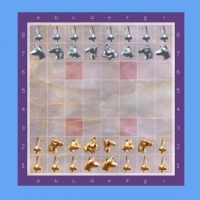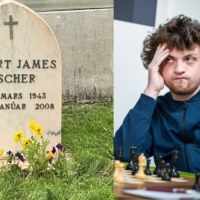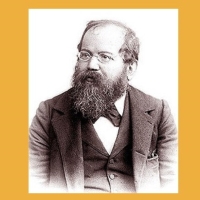Edward Winter has written a funny and perceptive piece about the faults of chess writers. The following review echoes many of his criticisms.
The Brain Games World Chess Championship
by Raymond Keene and Don Morris
Everyman, 2000
Review by Steve Giddins
It is often said that one only appreciates something once it has gone. It was only when the above tome landed on my doormat that I realised one of the benefits of us not having had a world championship match for five years – a five-year sabbatical from Raymondo’s instant match books! Well, all good things come to an end, I suppose, and this particular period of relief has certainly done so with a vengeance.
Ostensibly, this is a book about the Kasparov-Kramnik match, but one does not have to look at it for too long to realise that puffing the Braindead Network (henceforth referred to as BGN) is its main purpose. A secondary purpose is some gratuitous Mondo name-dropping, as the book starts with an introduction by none other than that well-known chess fan Tony Blair, Prime Minister. After his half page of predictable platitudes, we have a one-page ‘Welcome’ by The Right Honourable Sir Jeremy Hanley, KCMG (‘Keene Calls Me God’, perhaps?). This is followed by six more pages of propaganda about BGN’s plans for the future, including waffle about draughts, Chinese chess and even potted biographies of three English juniors, who between them boast a combined age of 24. All three are apparently the recipients of BGN largesse in the form of sponsorship, as if we cared.
Having got this far, the naive reader might be hoping for some chess from the match in question, but alas, not yet. First, we have to have a list of everybody connected with the match and the BGN itself, although as will be seen below, this turns out to be unexpectedly useful. Then we have the obligatory chapter on the history of the world chess championship, replete with all the usual crap about Steinitz crouching in the trenches, Botvinnik getting people to blow smoke in his face, etc. Those readers who are interested in the grisly details of precisely which bits were copied from which previous Keene books are referred to Edward Winter’s posting on the subject on the Chess Café bulletin board. Meanwhile, the padding proceeds apace, with a chapter on previous K-K encounters. By now, the weary reader has stumbled his way through to page 47 out of the total of 128 (i.e. over one third of the way through the book), and still has yet to see a pawn moved in anger.
Now, however, he is finally ‘rewarded’ with the games of the K-K match itself, annotated by Mondo. Those of you who have difficulty imagining the great man slaving for hours over a hot laptop will not be surprised to learn that concrete variations tend not to feature very prominently in these annotations. There are plenty of notes of the ‘Black now has an isolated pawn on e6’ and ‘White still has a majority of pawns on the K-side’ variety, but anybody looking for answers to the really difficult questions of the match will not find them here. A typical example is the disputed assessment of the endgame reached in Game 11. Kasparov claimed that 23 Ra1 (instead of his 23 Kf2) would have given him a winning advantage, something Kramnik flatly denied. Mondo’s note relates all of this, but there it stops. One might have thought that a Grandmaster, annotating the game in what purports to be the definitive book on the match, would make at least some attempt to analyse the position himself and express his view on such a fundamental difference of opinion. But oh no, not Mondo, and not in this book. Instead, he contents himself with telling us that Kramnik’s team had apparently devoted 30 hours of analysis to this very position – evidently 30 more than Mondo himself.
Instead, the space which could have been used for such analysis is filled up by a series of bizarre quotations from sundry Mondo allies, such as Tony Buzan and others. For example, the thought for the day on the aforementioned Game 11 is the following quote from (read: gratuitous plug for) Buzan’s new book: ‘Board games, especially chess and its variations … are terrific ways of improving your spatial intelligence. Each requires you to stretch and improve your spatial awareness, while simultaneously improving your analytic and strategic thinking skills…’ (p.104). Fine, but I’d rather see the fruits of Mondo’s analytic skills in respect of the position after 23 Ra1. Still, at least we now realise why page 14 of the book gives us a list of all the BGN officials. Presumably it is so that when the bewildered reader wonders who Michael Gelb is, he can look him up and see that he is a non-executive director of BGN. Quite why that should make his ramblings about tenth-century Arabian chess writings (p.109) of the slightest interest or relevance, however, is another question the book does not answer.
Finally, then, we stagger through to the end of Game 15 and the crowning of a new world champion. Even after displaying such fortitude, however, the poor reader is not spared another dose of BGN propaganda, as the last three pages of the book are taken up with yet more flannel about BGN’s plans for the future.
So, is there anyone to whom this book can be recommended? Well, certainly not to anyone who has access to the Internet (ironically enough, BGN’s great hope for the future), where, free of charge, all the games can be found with in-depth annotations by Kramnik’s team. Nor to anyone who subscribes to a major chess magazine, such as the BCM or New in Chess, where the games are also likely to be annotated more thoroughly than in this book. And not to anyone who is strong enough to recognise a doubled pawn or a bishop pair when he sees one, and instead wants answers to the more critical questions arising in the games. If you do not fall into any of these categories, and you are keen (pun intended) to own a rotten book about a boring match, then this could be the volume you’re looking for. For the rest of you, I suggest spending your chess book money on something more meritorious – ‘Trends in the Orang-Utan’, perhaps.
First published in Kingpin 33 (Winter 2000)












